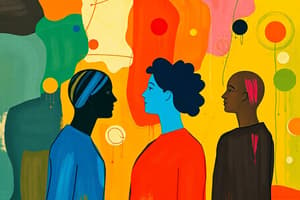Podcast
Questions and Answers
According to group dynamics, what is emphasized within a group setting?
According to group dynamics, what is emphasized within a group setting?
- Strict adherence to individualistic goals.
- Hierarchical leadership structures.
- Democratic leadership and member participation. (correct)
- Competitive environments to foster innovation.
In the context of group dynamics, how did Kurt Lewin contribute to the understanding of groups?
In the context of group dynamics, how did Kurt Lewin contribute to the understanding of groups?
- He defined the stages of group development.
- He advocated for authoritarian leadership in group settings.
- He defined a normative view describing how groups form, function, and affect their members. (correct)
- He dismissed the term 'group' as an ambiguous concept.
Which of the following is the most accurate definition of group dynamics?
Which of the following is the most accurate definition of group dynamics?
- A static collection of individuals working independently.
- A system of behaviors and psychological processes occurring within or between groups. (correct)
- A rigid structure that dictates individual roles within a team.
- A financial model for predicting team performance.
A company decides to reorganize its departments to foster better teamwork, focusing on open communication and shared decision-making. Which aspect of group dynamics are they primarily addressing?
A company decides to reorganize its departments to foster better teamwork, focusing on open communication and shared decision-making. Which aspect of group dynamics are they primarily addressing?
Which of the following scenarios best illustrates the 'security' motive for joining a group?
Which of the following scenarios best illustrates the 'security' motive for joining a group?
According to the provided content, what is the primary reason people seek 'status' by joining groups?
According to the provided content, what is the primary reason people seek 'status' by joining groups?
Which of the following scenarios illustrates the 'goal achievement' reason for group formation?
Which of the following scenarios illustrates the 'goal achievement' reason for group formation?
How does 'propinquity theory' explain the formation of groups in organizational settings?
How does 'propinquity theory' explain the formation of groups in organizational settings?
According to 'exchange theory', what role do rewards and costs play in group formation and interaction?
According to 'exchange theory', what role do rewards and costs play in group formation and interaction?
According to balance theory, what is the significance of shared attitudes, goals, and values within a group?
According to balance theory, what is the significance of shared attitudes, goals, and values within a group?
In the context of Homan's theory, what elements are considered essential for group formation?
In the context of Homan's theory, what elements are considered essential for group formation?
What is the primary focus during the 'forming' stage of group development?
What is the primary focus during the 'forming' stage of group development?
How does the 'storming' stage differ from the 'norming' stage in group development?
How does the 'storming' stage differ from the 'norming' stage in group development?
What characterizes the 'performing' stage of group development?
What characterizes the 'performing' stage of group development?
According to the provided content, what distinguishes secondary groups from primary groups?
According to the provided content, what distinguishes secondary groups from primary groups?
Flashcards
Group Dynamics
Group Dynamics
A system of behaviors and psychological processes occurring within groups (intragroup) or between groups (intergroup).
Study of Group Dynamics
Study of Group Dynamics
Useful in understanding decision-making behavior, attitudes, opinions, beliefs, interrelationships, discrimination, communication, perceptions, and attributions within a group.
Emphasis of Group Dynamics
Emphasis of Group Dynamics
Emphasizes democratic leadership, member participation, and overall cooperation within group settings.
Group Definition
Group Definition
Signup and view all the flashcards
Security in Groups
Security in Groups
Signup and view all the flashcards
Status in Groups
Status in Groups
Signup and view all the flashcards
Self-Esteem in Groups
Self-Esteem in Groups
Signup and view all the flashcards
Affiliation in Groups
Affiliation in Groups
Signup and view all the flashcards
Power in Groups
Power in Groups
Signup and view all the flashcards
Goal Achievement in Groups
Goal Achievement in Groups
Signup and view all the flashcards
Propinquity Theory
Propinquity Theory
Signup and view all the flashcards
Exchange Theory
Exchange Theory
Signup and view all the flashcards
Balance Theory
Balance Theory
Signup and view all the flashcards
Homan's Theory
Homan's Theory
Signup and view all the flashcards
Primary Groups
Primary Groups
Signup and view all the flashcards
Study Notes
Introduction to Groups
- Group dynamics involves behaviors and psychological processes within or between groups.
- Studying group dynamics aids understanding of decision-making, attitudes, communication, and perceptions.
- Kurt Lewin popularized the term "group" in the 1930s.
- Lewin described how groups form, their structure, and how they affect members and the organization.
- Group dynamics emphasizes democratic leadership, member participation, and cooperation.
- Group dynamics include interpersonal attraction, social relationships, conflict resolution, communication, conformity, deviance, and group therapy.
- A group is two or more people with common objectives, mutual stimulation, loyalty, shared activities, and a recognized structure.
Why People Join Groups
- Joining a group reduces insecurity.
- Group inclusion provides recognition and status.
- Groups can provide self-worth.
- Groups fulfill social needs.
- Group action makes more possible than individual action
- Management relies on formal groups to pool talents, knowledge, or power to complete a job.
Theories Explaining Why People Join Groups
- Propinquity Theory: Individuals affiliate due to spatial or geographical proximity like employees in the same area.
- Exchange Theory: This theory is based on reward-cost outcome of interactions. Rewards from interactions gratify needs, while costs incur anxiety, frustrations, or fatigue.
- Balance Theory by Theodore Newcomb: People are attracted based on similar attitudes and relevant goals.
- The members strive to maintain a symmetrical balance and restore it if imbalance occurs.
- Homan's Theory by George C. Homan: Group formation is based on activities, interactions, and sentiments.
- Shared actvities lead to more interaction.
- Interactions build their sentiments.
- Interaction is the major element that can accomplish group goals such as cooperation and problem solving.
Stages of Group Development
- Forming: Members are well-acquainted, establish ground rules, remain formal, and treat each other as strangers.
- Storming: Members communicate feelings but view themselves as separate, resist leadership, and show hostility.
- Norming: People feel part of the group and realize that they can achieve the goal if they accept other viewpoints.
- Performing: The group work is based on open and trusting atmosphere where flexibility is important.
- Adjourning: The group conduct an assessment & transition, and members contributions are recognized. Once the goal is achieved, the group disband.
Types of Groups
- Charles Horton Cooley introduced primary and secondary groups in 1909.
- Primary groups have continuous face-to-face interaction and a strong 'we feeling'.
- They are based on permanence, affection, multifaceted relationships, and non-task orientation like family.
- Secondary groups have limited interaction, ties of exchange, and task-oriented relationships.
- Secondary groups are defined by the organization's structure and directed towards goals, like clubs and trade unions.
Studying That Suits You
Use AI to generate personalized quizzes and flashcards to suit your learning preferences.




